Synthetic biology company OPX Biotech secures $3.6 million in funding for next generation biofuels technology
 OPX Biotechnologies, Inc., a new company dedicated to enabling economically viable biofuels and biorefined chemicals through synthetic biology research announces that it has secured $3.6 million in venture funding led by Mohr Davidow Ventures (MDV), a leading Silicon Valley-based venture capital firm.
OPX Biotechnologies, Inc., a new company dedicated to enabling economically viable biofuels and biorefined chemicals through synthetic biology research announces that it has secured $3.6 million in venture funding led by Mohr Davidow Ventures (MDV), a leading Silicon Valley-based venture capital firm.OPX has developed a first-of-its-kind genomics technology platform known as SCALEs (SCalar Analysis of Library Enrichments) that enables massively parallel full genome search, identification of specific causative genes, and rapid genetic modification and testing. The platform allows OPX to identify the role of each gene and how to modify it to achieve the characteristics needed for specific fuel and chemical products 1000 to 5000 times faster than conventional methods. The result is to quickly engineer new microbes to provide major improvements in tolerance, productivity, and specificity for fuel and chemicals production using biological processes. This might vastly decrease the production costs and capital requirements for renewal fuels and chemicals. SCALEs is based on pioneering genomics work by Professor Ryan Gill and Dr. Michael Lynch at the University of Colorado.
OPX has the potential to address one of the great challenges of our time - meeting the tremendous demand for renewable fuels and chemicals that are cost competitive and superior to petroleum-based products with far lower carbon emissions. Their proprietary, first of its kind massively parallel, full genome search and gene modification technology platform is a major breakthrough in synthetic biology that could vastly reduce the time it takes to design the microbes needed for economically viable biofuels and biorefined chemicals. - Erik Straser, MDV general partnerSynthetic biology is a rapidly emerging, disruptive science field with great promise for the production of abundant biofuels and renewable, innovative bioproducts (previous post). It is based on collecting and sequencing large amounts of genetic material from the environment (from microorganisms in oceans, soils, etc), analyzing and matching the most interesting sequences to recombine and reorganize them so that they are programmed to carry out a specific bioconversion process; the synthetically engineered 'building blocks' are then inserted into (micro)organisms or used as such as artificial 'biological machines', which perform the desired task (schematic, click to enlarge).
Besides Mohr Davidow Ventures, a major Silicon Valley venture firm and one of the top investors in the clean technology field, X/Seed Capital, a leading seed stage venture firm, invested in OPX earlier and participated again in this second round:
 energy :: sustainability :: biomass :: bioenergy :: biofuels :: bioproducts :: synthetic biology :: genomics :: biotechnology :: bioeconomy ::
energy :: sustainability :: biomass :: bioenergy :: biofuels :: bioproducts :: synthetic biology :: genomics :: biotechnology :: bioeconomy :: OPX received seed financing from X/Seed in June, 2007.
The company further announced that it appointed Rob Chess Chairman and CEO. Chess serves on the Board of Directors of the Biotechnology Industry Organization (BIO). He received his B.S. degree in Engineering from the California Institute of Technology and an M.B.A. from Harvard. Chess has held leading positions in Nektar Therapeutics, a company that develops improved pharmaceutical products using its innovative drug delivery platforms, and was co-founder and President of Penederm, Inc., a publicly-traded dermatological pharmaceutical company that was sold to Mylan Laboratories. He has held management positions at Intel Corporation and Metaphor Computer Systems (now part of IBM), and was a member of the first President Bush's White House staff.
The OPX Board of Directors includes MDV's Erik Straser, X/Seed's Michael Borrus, Professor Ryan Gill, a co-founder of the company and the Patten Assistant Professor of Chemical Engineering at University of Colorado, and Rob Chess as Chairman and CEO.
Mohr Davidow Ventures is a leading Silicon Valley-based venture capital firm that for 25 years has identified, mentored and developed entrepreneurs and young companies redefining business, technology and medicine. MDV has $2 billion dollars under management.
X/Seed Capital is an early-stage venture firm that provides seed capital for breakthrough innovators. X/Seed was founded in 2006 and is based in Silicon Valley.
Schematic: from DNA collection to reprogrammed microorganism. Credit: Synthetic genomics.
References:
Michael D Lynch, Tanya Warnecke & Ryan T Gill. “SCALEs: multiscale analysis of library enrichment”, Nature Methods - 4, 87 - 93 (2007), doi:10.1038/nmeth946
Ryan T. Gill, Tanya Warnecke, Michael D. Lynch, Amarjeet Singh, "Using Genomics to Direct Strain Selections", AIChE 2007 Annual Meeting, Biomolecular Engineering.
Article continues
 --------------
--------------
 Taiwan's Feng Chia University has succeeded in boosting the production of hydrogen from biomass to 15 liters per hour, one of the world's highest biohydrogen production rates, a researcher at the university said Friday. The research team managed to produce hydrogen and carbon dioxide (which can be captured and stored) from the fermentation of different strains of anaerobes in a sugar cane-based liquefied mixture. The highest yield was obtained by the Clostridium bacterium.
Taiwan's Feng Chia University has succeeded in boosting the production of hydrogen from biomass to 15 liters per hour, one of the world's highest biohydrogen production rates, a researcher at the university said Friday. The research team managed to produce hydrogen and carbon dioxide (which can be captured and stored) from the fermentation of different strains of anaerobes in a sugar cane-based liquefied mixture. The highest yield was obtained by the Clostridium bacterium.

 A new study by one of the world's leading forestry research institutes
A new study by one of the world's leading forestry research institutes  Under its 11th Plan period (2007-2012), the government of India aims to add 1,700 MW capacity through biomass and bagasse cogeneration in various states, including Maharashtra, Uttar Pradesh, Tamil Nadu and Karnataka, the Lok Sabha (Lower House) was informed today.
Under its 11th Plan period (2007-2012), the government of India aims to add 1,700 MW capacity through biomass and bagasse cogeneration in various states, including Maharashtra, Uttar Pradesh, Tamil Nadu and Karnataka, the Lok Sabha (Lower House) was informed today.
 SciDev is running an interesting
SciDev is running an interesting  A new species of bacteria
A new species of bacteria 
 The trend toward increasing production of biofuels provides an opportunity to dismantle agricultural subsidies and tariffs in wealthy countries, according to the International Monetary Fund’s top economist. Non-governmental organisations and developing country governments have been calling for farm subsidy and trade reform for years, to give producers in the South a chance to develop domestic markets. Biofuels offer an opportunity to bring about this much needed transformation.
The trend toward increasing production of biofuels provides an opportunity to dismantle agricultural subsidies and tariffs in wealthy countries, according to the International Monetary Fund’s top economist. Non-governmental organisations and developing country governments have been calling for farm subsidy and trade reform for years, to give producers in the South a chance to develop domestic markets. Biofuels offer an opportunity to bring about this much needed transformation. After months of negotiations and intense lobbying by different sectors, South Africa has approved its long awaited biofuels plan. The country will aim to have biofuels account for 2 percent of its total fuel production by 2013 but will exclude the staple maize as a source. Compared to most other sub-Saharan African countries, South Africa an extremely small per capita potential for the production of biofuels and thus has to be far more careful in setting targets.
After months of negotiations and intense lobbying by different sectors, South Africa has approved its long awaited biofuels plan. The country will aim to have biofuels account for 2 percent of its total fuel production by 2013 but will exclude the staple maize as a source. Compared to most other sub-Saharan African countries, South Africa an extremely small per capita potential for the production of biofuels and thus has to be far more careful in setting targets.
 Healthy ecosystems that provide people with essential natural goods and services often overlap with regions rich in biological diversity, underscoring that conserving one also protects the other, according to a new paper
Healthy ecosystems that provide people with essential natural goods and services often overlap with regions rich in biological diversity, underscoring that conserving one also protects the other, according to a new paper 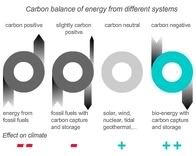 In an interesting development, EESTech, Inc. today
In an interesting development, EESTech, Inc. today 



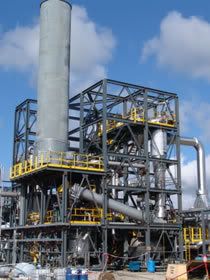 Dynamotive recently successfully demonstrated its large commercial plant in Guelph, Ontario, with over seventy-five global biofuel experts attending. Amongst them were scientists from the International Energy Agency's
Dynamotive recently successfully demonstrated its large commercial plant in Guelph, Ontario, with over seventy-five global biofuel experts attending. Amongst them were scientists from the International Energy Agency's  Thenergo, a Belgian renewable energy company today
Thenergo, a Belgian renewable energy company today 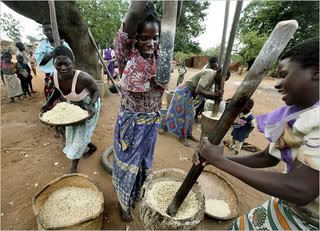




 One often hears about the potential of bioenergy to boost the incomes of poor rural households. From China now come the
One often hears about the potential of bioenergy to boost the incomes of poor rural households. From China now come the 

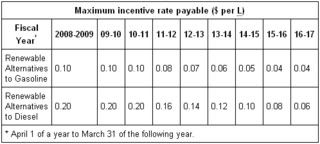

 A bioprospecting expedition to Iceland's famed hot springs has yielded new strains of bacteria with potential of producing biohydrogen (H2) and ethanol (EtOH) fuels from biomass and waste materials containing carbohydrates. The report about the discovery of the new thermophilic microbes appeared online as an
A bioprospecting expedition to Iceland's famed hot springs has yielded new strains of bacteria with potential of producing biohydrogen (H2) and ethanol (EtOH) fuels from biomass and waste materials containing carbohydrates. The report about the discovery of the new thermophilic microbes appeared online as an  Deforestation in tropical countries is often driven by the economic reality that forests are worth more dead than alive. But a new study by an international consortium of researchers has
Deforestation in tropical countries is often driven by the economic reality that forests are worth more dead than alive. But a new study by an international consortium of researchers has  The University of Northern Iowa's Tallgrass Prairie Center is
The University of Northern Iowa's Tallgrass Prairie Center is  According to the Philippine Department of Agriculture, Spanish biodiesel firm
According to the Philippine Department of Agriculture, Spanish biodiesel firm 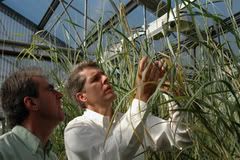 Energy crop company Ceres, Inc.
Energy crop company Ceres, Inc.  Jacques Cassiman, a famous European geneticist with a heart for Africa, was once asked what the future has in store for Europe's youth, who live in a continent whose population is ageing rapidly. His answer: in a 'reverse migration' of sorts, the creative and courageous ones will move to Africa, where they will find countless exciting opportunities no longer available in the old, grey continent. And when they migrate, they will be surprised to find many Chinese collegues in their newfound African homeland.
Jacques Cassiman, a famous European geneticist with a heart for Africa, was once asked what the future has in store for Europe's youth, who live in a continent whose population is ageing rapidly. His answer: in a 'reverse migration' of sorts, the creative and courageous ones will move to Africa, where they will find countless exciting opportunities no longer available in the old, grey continent. And when they migrate, they will be surprised to find many Chinese collegues in their newfound African homeland.







Saturday, December 08, 2007
Nigeria's Imo State launches large palm oil programme to shake off oil curse
Agriculture is the traditional occupation of the Nigerian people, he writes. Prior to the discovery and consequent exploration of mineral oil in the country, the economy of the nation stood on the tripod of palm oil, cocoa and groundnut production. These cash crops were produced not just for subsistence but also for export. While the south east region produced palm oil, the south west was into cocoa production and the north was well known for its groundnut pyramids. Each of the regions was doing well in its area of strength and the country was already on its way to economic independence.
The young people preferred to look for white collar jobs instead of engaging in farm work. The government on its part was more concerned with the wealth coming in from crude mineral oil to bother about providing incentives to encourage agriculture. Being ignorant of the great potentials of palm oil, the people threw away their chance of earning an enviable place in the great economies of the world. Currently, Malaysia which came here to learn about palm oil production is the world's number one producer and exporter of crude palm oil, closely followed by Indonesia. Having discovered the unparalleled productivity and huge benefits of investing in palm oil production, reports indicate that currently almost half of Malaysia's cultivated land consists of oil palm.
In 2004, according to reports, Indonesia cultivated oil palm plantations which covered 5.3 hectares of land. These plantations generated 11.4 million metric tons of palm oil with an export value of US$ 4.43 billion and brought in $42.4 million to the Indonesian treasury. Of course since then, the value of the product has continued to climb, making it almost competitive to petroleum.
Now the basic questions are; why has palm oil become the world's number one fruit crop? Why the sudden surge in the demand for palm oil? How did something Nigerians, nay Igbo threw aside become so valued in the world market? Well, apart from being a major ingredient for food, palm oil has other myriad uses. It is used in cosmetics production and more importantly one of the raw materials in biodiesel production. According to experts, biodiesels are biodegradable and, when burned, have fewer emissions than petroleum-based fuels. Thus, biodiesels are being looked upon as possible alternative energy source:
Because of this development, environmentalists have been supportive of biofuels and other world bodies have voted for the idea of reducing dependence on Middle East oil since many biodiesel crops can be grown in friendly territories. With this in mind, policymakers from Asia and Europe have shown interest and have made a major push to promote and adopt biofuels. These developments have all contributed to increased investment in palm oil production.
To cash in on this, Indonesia has reportedly announced that it intends to double its oil palm crude production by 2025. Under a 2005 investment proposal, prepared by the State Plantation Corporation PT Perkenuan Nusantara (PTPN), Indonesia would develop about 1.8 million hectares of land for palm plantation. China would be involved in the plan, reportedly investing $7.5 billion in energy and infrastructure projects, including providing capital for palm oil plantations. The project is expected to employ nearly 400,000 people and generate an annual inflow of $45 million in tax revenue to the state.
Despite these, oil palm is not native to Asia. It is native to Igboland but what have we gained from it? In one word, nothing. Not because the palm tree has refused to yield its precious oil to us but because we have neglected a veritable source of revenue in our pursuit of the easy money. Our over dependence on mineral oil has not done even half of what palm oil has done for Malaysia and Indonesia. The country has continued to tether on the brink of collapse as the Niger Deltans battle the rest of the country for the control of oil exploration rights. Today, if they sneeze the whole country catches cold.
Development programme
Knowing the dangers inherent in depending on the crude mineral oil, and having become aware of the great potentials and investment opportunities of palm oil, the knowledgeable in the land are poised to reverse the trends in agriculture. The government of Chief Ikedi Ohakim of Imo state is one of those who have decided to take a plunge in what comes natural to our land - investment in palm oil production. In the draft presentation of the Imo State Oil Palm Development Programme (ISODEP), the government declared that it is set to claim for the state the number one position in oil palm production in the country.
The vision of ISODEP is to create an alternative economic revenue base and lay a solid foundation for agric-business in Imo state as part of the millennium development goals critical objectives. The programme also seeks to reawaken the consciousness of Imo people to the nativity of palm tree and use the palm tree as a start-up tool for the clean and green initiative of the state government.
Under the programme, the state government seeks to raise and distribute four million tenera oil palm for planting through small holder's management unit in every community in the state within a four-year period. The government is also set to produce palm oil cluster centres and establish semi-automated oil mills in each nucleus in the 27 local government areas in the state. Ultimately however, Ohakim's government sees in the programme an avenue to significantly reduce poverty, enhance rural community development and create employment opportunities for the citizens. The government is also hopeful that this foundation project if handled well would attract foreign investment into the state's agriculture sector.
Despite these laudable objectives however, the programme would not be a piece of cake to implement, especially knowing the disdain the young people in the state have for farming. Also, ignorance concerning the marketability of palm oil will have to be erased from the minds of the citizens before any major breakthrough could be made for without the full participation of the people the project will not have the effect government is projecting. Also, how prepared is government to establish the oil mills to ease the burden and hard work associated with palm oil production seeing that it was a main reason for the quick abandonment of the business at the first sign of an alternative way of making a living?
Commenting on the development, the state's commissioner for agriculture and natural resources, Chief Longers Anyanwu said government is willing to do all it takes to ensure the success of the programme. He said plans for the establishment of the mills had already reached advanced stage.
He disclosed that the state government plans to encourage youth participation by using secondary school students to distribute the palm seedlings. And to express its desire to see that the programme succeeds, the commissioner said all the executive members of Ohakim's government have been mandated to plant about 1000 palm seedlings as their contribution and as a sign of government's commitment to the revitalisation of oil palm production in the state.
The commissioner said it was also in government's plan to replace all the old and wild palm trees in the state with the improved species of tenera to ensure high production of palm oil for export purposes. In this regard, the association of oil palm producers in the state have declared their readiness to partner with government in its march to inject life into the business of palm oil production. Speaking on the renewed interest of government in palm oil production,Bernard Emecheta said government's plan is a welcome development and expressed confidence that they are capable of seeing it through.
He said palm oil production declined because of continued government neglect and the inability of the local producers to get any form of incentive from the government. He expressed regret over the fate of the state-owned Adapalm; an oil palm plantation company which he said has been in steady decline through poor management and government neglect. 'If a big company like Adapalm which used to record huge revenue for the state government could be allowed to waste away like that what do private palm oil producers have in government being interested in our affairs?' He remarked that with this renewed interest by government in palm oil production, the state has a good chance of at least increasing its internally generated revenue as well as curb the raging unemployment among the youth.
Already the state is collaborating with the Nigerian Agip company to realise this revolution. At a meeting held recently at the company's headquarters in Port Harcourt, the oil giants asked the state ministry of agriculture and natural resources to design a plan of action for that purpose. The company has in principle approved the erection of an administrative block and nursery sheds to support government in its bid to revitalise the oil palm sector. In this connection, Chief Anyanwu has already swung into action by providing a plot of land for the immediate take off of the projects. Discussions are also underway with Shell Petroleum Development Company for purposes of assisting government achieve its dream in this same direction.
Hopefully the 'new face of Imo' as the Ohakim government delights to be called will not go the way of previous governments in the state who only pay lip service to developmental issues. Palm oil production as other countries have discovered is big business, big enough to save this country from the heart ache of incessant unrest in the Niger Delta. All it requires really is leadership that is capable of trusting in its ability to bring about positive change. It's all about reorientation of the mind of the local populace that palm oil business is as good as mineral oil bunkering but without the hazards associated with the later.
References:
Vanguard: 4 million trees coming to restore Nigeria’s oil palm glory — ANYANWU [*.pdf] - October 7, 2007.
This Day (Lagos) (via AllAfrica): Palm Oil Production As Linchpin to Imo Agric Revolution - December 3, 2007.
The Nigerian Institute for Oil Palm Research.
Article continues
posted by Biopact team at 5:26 PM 1 comments links to this post
